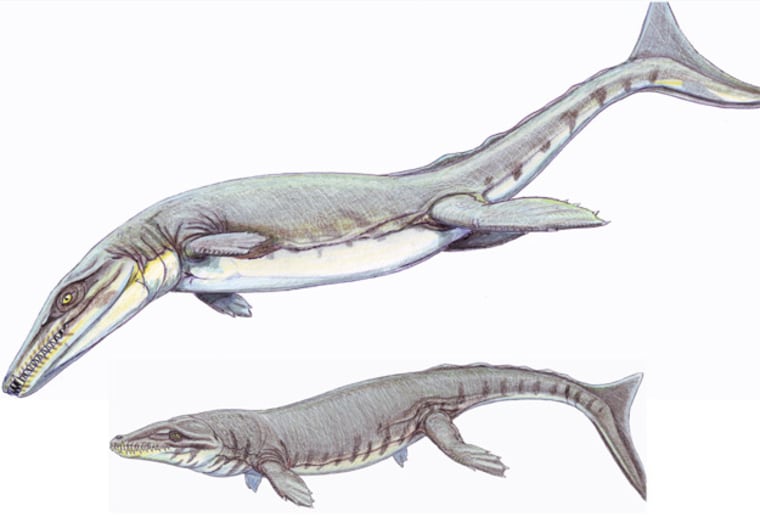Like an underwater T. Rex, marine mega meat-eaters ripped into prey with massive, serrated teeth some 171 to 136 million years ago to satisfy a diet of at least 70 percent flesh.
What's more, metriorhynchids, the extinct relatives of today's crocodiles, had a killing skill that T. Rex lacked: The death roll. The creatures would sink their teeth into prey and then spin their bodies in the water to tear out large chunks of flesh.
New findings show how adaptations for a mega meat-eating lifestyle extended to some full-time water dwellers as well as to certain land-based animals, like dinosaurs.
The paper, published in the Journal of Vertebrate Paleontology, focused on three metriorhynchids from the Middle Jurassic to the Early Cretaceous: Dakosaurus, Geosaurus and the newly named Torvoneustes. All three were "hypercarnivores," which lead author Marco Brandalise de Andrade, defines as a carnivore with a diet made up of at least 70 percent meat.
"On top of that, hypercarnivores are usually of medium to large size, are active hunters (not just scavengers) and are able to hunt prey larger than themselves." de Andrade told Discovery News.
"Hypercarnivores are at the top of the food chain, and adults are rarely included on the menu of other hunters," added de Andrade, a member of the Paleobiology & Biodiversity Research Group at the University of Bristol.
For the study, he and colleagues Mark Young, Julia Desojo and Stephen Brusatte analyzed fossils of the prehistoric crocodile relatives, which are thought to have lived most, if not all, of their lives underwater in the Nusplingen and Solnhafen Seas that once existed near what is now Germany. They also performed electron microscopy on teeth belonging to these meat-loving predators.
They determined the teeth of Dakosaurus were extremely sharp and serrated, comparable to those of T. rex.
"Both Dakosaurus and Tyrannosaurus had proportionately large teeth, with robust, poorly flattened crowns, and macroscopic serrations," de Andrade said. "Taking the T. Rex as an analog for tooth biomechanics, Dakosaurus would be able to deliver a fierce powerful bite, damaging flesh, bones and even armor."
Dakosaurus might have even been a more successful hunter than carnivorous dinosaurs like T. Rex — thanks to its death roll.
"The coolest thing about the death roll is that it becomes exponentially more efficient with body size: the larger the Dakosaurus or Geosaurus, the greater the damage!" said de Andrade.
While it's possible that large sharks could have fed on adult metriorhynchids, no physical evidence has been found to prove it. Charcarodon megalodon, believed to have been the world's largest and most powerful shark, appeared much later in Earth's history.
"The only predators Geosaurus and Dakosaurus would have had were the pliosaurs," Young said. "During the time Geosaurus and Dakosaurus lived, that meant Liopleurodon and Pliosaurus. Both were 33 feet-plus carnivores, and would have been at the top of the food chain."
Geosaurusand Dakosaurus swam in the same seas, likely because each targeted different prey. Dakosaurus, with its T. rex-like skull and teeth, would have been able to feed on large marine reptiles, fish and cephalopods. Geosaurus, on the other hand, had a streamlined body and a lighter skull. Its teeth were better at slicing through soft bodied, fleshy prey.
Andrea Cau of the University of Bologna's Giovanni Capellini Geological Museum told Discovery News, "This study opens a new and unexpected perspective on the evolution and paleoecology of these marine predators."
